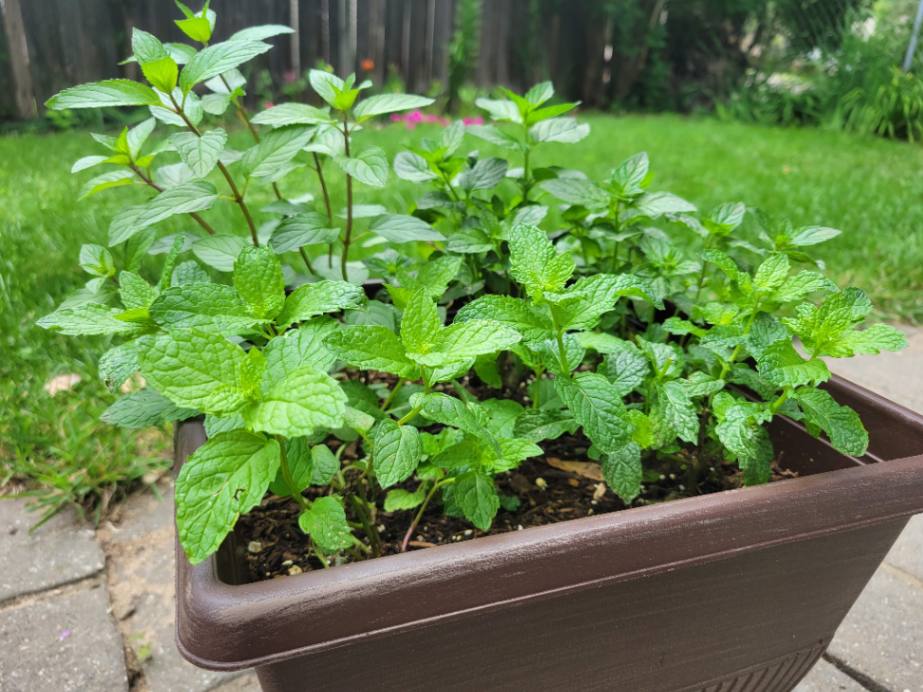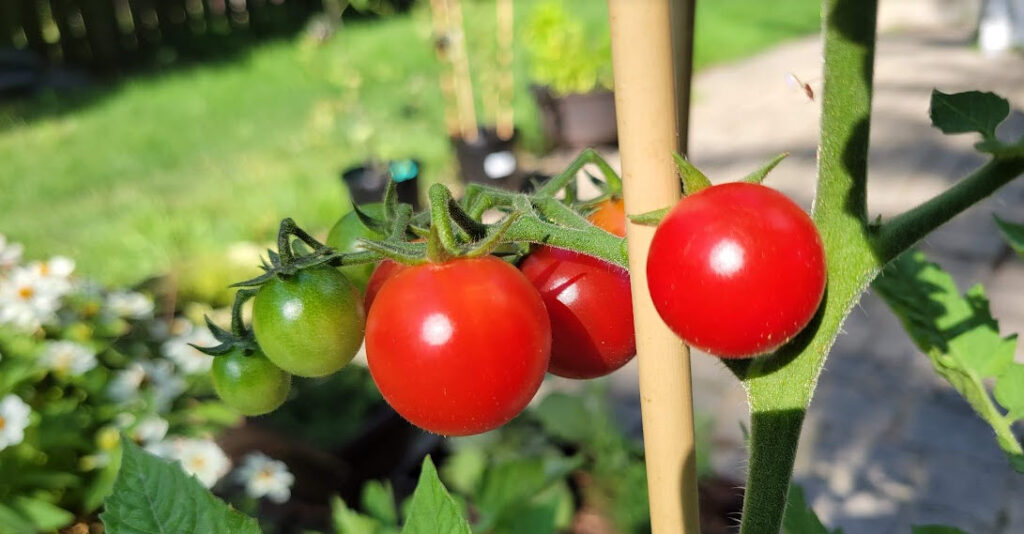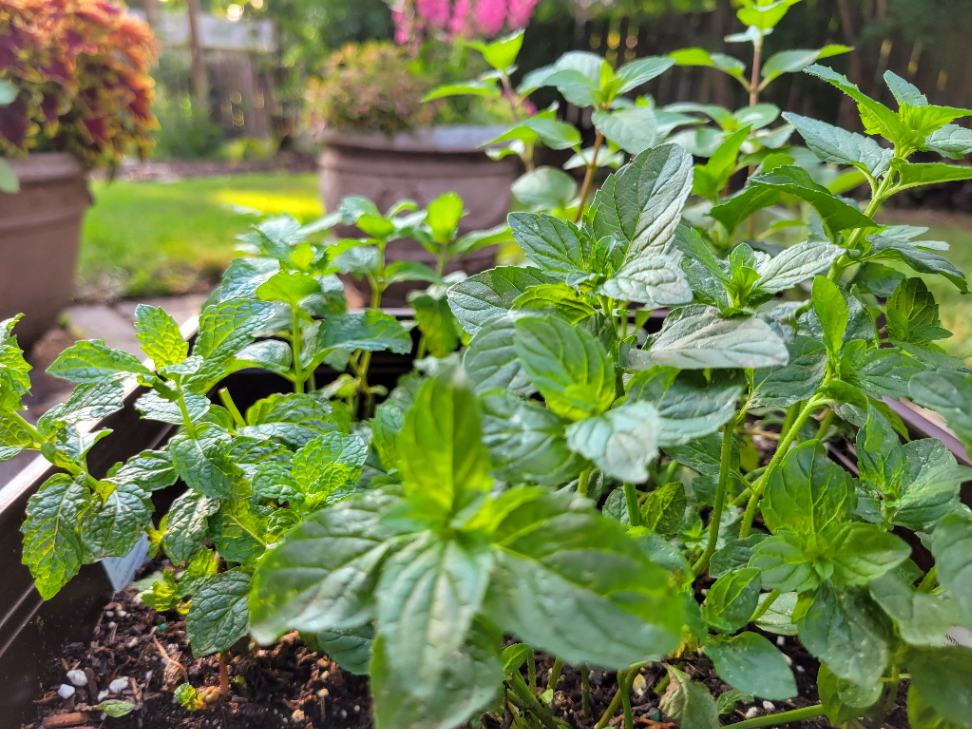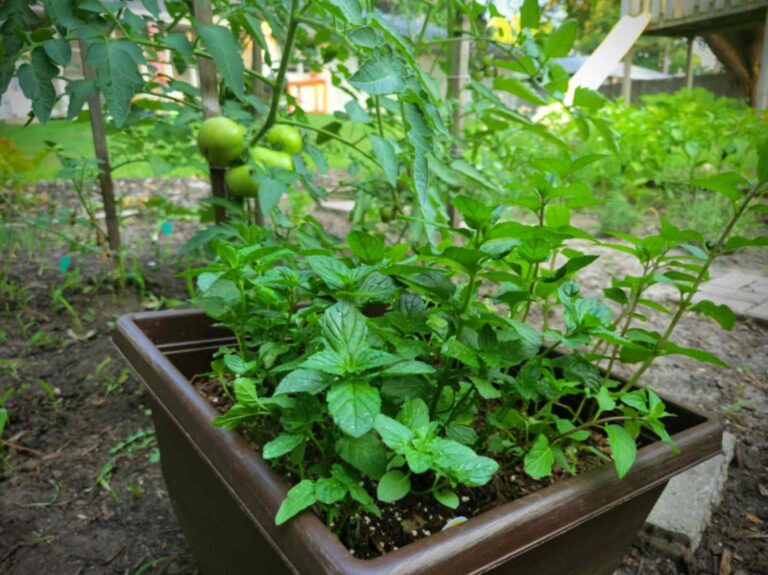This post may contain affiliate links which means I may receive a commission for purchases made through links. I only recommend products that I have personally used. As an Amazon Associate I earn from qualifying purchases. Learn more on my Private Policy page.

Mint holds great potential as a companion plant for gardeners seeking natural pest control methods. Its strong scent repels numerous garden pests that can damage other plants in your garden. But be careful because mint can spread quickly and take over other plants. If you manage it well, mint companion planting can help create a garden that is resistant to pests.
What grows well with mint? Mint grows well with vegetables such as tomatoes, peppers, cabbage, broccoli, carrots, and onions, as it is a natural insect repellent. However, it is advisable to plant mint in containers due to its rapidly spreading nature to prevent it from overtaking your garden.
Table of Contents
Mint Invasion: A Cautionary Tale
Mint, though favored by many gardeners, can quickly become invasive without proper management. This cautionary tale highlights the importance of containing mint, the issues unchecked mint growth presents, and practical ways to keep it under control.
The Menace of Mint Roots
Mint roots have a remarkable ability to spread rapidly underground, sending out new shoots and taking hold of your garden. If left unchecked, these roots can infiltrate nearby plant beds, choking out other vegetation.

My Battle with Mint
When I first moved into my current residence in Minnesota a bit over a decade ago, I was pleasantly surprised to find a small spearmint patch coming up in the garden that first spring. I’d never grown mint before, so I was eager to try growing it. To my displeasure, the mint patch quickly took over the neighboring herbs.
I was hopeful that our harsh Minnesota winters would help to suppress the mint from spreading, but that was not to be the case. The mint patch ended up taking over a far wider area the next year, and my attempts to manually weed it out of the garden were in vain, as the root runners were thick and well-established.
That fall, I put down several layers of thick cardboard over the entire mint patch and covered it with autumn leaves for the winter. I left it there for most of the next spring and didn’t remove it until early June. Thankfully, that did the trick. I no longer have mint in my garden. I now only ever grow mint in containers.
In summary, it was challenging for me to write this article about mint companion planting, as it was my initial instinct to state that nothing grows well with mint due to its invasive nature. However, Mint’s incredible insect-repelling properties warrant a second look at using various types of mint as garden companion plants.
Strategies for Taming Mint Growth
Implementing effective strategies to control its invasive tendencies is essential when growing mint in your garden.
- Container Planting: Growing mint in containers is the most foolproof way to prevent its invasive tendencies. Use pots or raised beds to confine the roots and limit their ability to spread. Growing mint in containers is now the only way I ever grow mint.
Purchase outdoor gardening pots from Amazon
- Root Barriers: Installing physical barriers, such as plastic edging or buried containers, can help restrict the underground spread of mint roots.
Purchase landscape edging from Amazon
- Vigilance and Monitoring: Keep a close eye on any garden areas where mint has been planted. Act promptly if you notice any signs of spreading or encroachment into neighboring beds.

Brassica Companions: Cabbage, Broccoli, Kale and Cauliflower
Most types of mint act as a natural repellent against common pests that often plague brassica crops. Let’s explore why brassicas like cabbage, broccoli, kale, and cauliflower make excellent companions for this aromatic herb. Plant mint in containers near your brassica plants to ward off pests naturally.
Mint Repels Common Brassica Pests
One of the primary advantages of incorporating mint into your garden near members of the brassica family is its ability to repel pests such as cabbage worms and flea beetles, which can wreak havoc on your crops and cause extensive damage. The pungent scent emitted by mint acts as a deterrent for these pests, effectively protecting your brassicas.
Cabbage: A Mint Companion

Cabbage is an exceptional companion for mint due to their mutual benefits. Mint repels cabbage moths and flea beetles that commonly affect cabbage plants, and cabbage can provide shade to the lower-growing mint, which thrives best in shady conditions. This symbiotic relationship creates a harmonious environment where both plants can flourish, but be vigilant to ensure mint does not spread into the rest of your garden.
Purchase cabbage seed varieties from SeedsNow
Broccoli and Mint Pairing

Broccoli and mint make great companions in the garden. Similar to cabbage, broccoli benefits from the pest-repellent properties of mint. Mint’s aromatic qualities help to deter pests that commonly affect broccoli, such as cabbage worms and aphids. The strong scent of mint can mask the odors emitted by broccoli that attract these insects, reducing the risk of infestation and promoting healthier broccoli plants.
Purchase broccoli seed varieties from SeedsNow
Kale and Mint as Garden Partners

Like other brassicas, kale faces threats from various pests such as aphids and flea beetles. By introducing mint into the mix, you fortify your kale plants against these pests. Furthermore, the shade provided by kale’s broad leaves creates a suitable environment for mint to thrive. Make sure to exercise caution to confine the spread of mint and protect the integrity of the remaining garden.
Purchase kale plants from Amazon or kale seed varieties from SeedsNow
Cauliflower and Mint: A Dynamic Duo

Cauliflower and mint form a dynamic duo when planted together. Like other brassicas, cauliflower is susceptible to pests such as cabbage worms and flea beetles. By planting mint nearby, you can effectively deter these pests from causing harm to your cauliflower. The lush foliage of cauliflower provides an ideal shade for mint, ensuring it receives the right amount of sunlight while protecting it from excessive heat.
Purchase cauliflower seed varieties from SeedsNow
Root Vegetable Companions: Carrots, Onions and Radishes
Growing root vegetables like carrots, onions, and radishes near mint in your garden can be beneficial due to mint’s insect-repelling properties. For a natural defense against pests, cultivate mint in containers in proximity to your root vegetables.
Carrots and Mint: Mint’s Pest-Repelling Powers

Carrots are susceptible to various pests that can damage their delicate roots. By planting mint near your carrot patch, you can naturally repel many of these unwanted visitors. Mint emits a strong scent that acts as a deterrent to insects such as aphids, flea beetles, and carrot flies. These pests find the aroma of mint overwhelming, and they are less likely to bother your carrots when they are planted near mint.
Purchase carrot variety seeds from SeedsNow
Onions and Mint Pairing Benefits

Onions can greatly benefit from being planted alongside mint, as mint acts as a natural insect repellent for onions. By planting these two companions in your vegetable garden near each other, you create an environment that is less attractive to pests like onion maggots and thrips. This means healthier onion plants with fewer pest-related issues.
Purchase onion sets and transplants from SeedsNow or Amazon
Radishes: A Perfect Match for Mint

Mint’s robust aroma naturally repels pests like flea beetles, typically troublesome for radishes. By concealing the radish smell, mint aids in decreasing infestation risks and safeguards the plants. Mint can also attract beneficial insects like bees and predatory wasps which provide natural pest control for radishes.
Purchase radish seed varieties from SeedsNow
Boost yields with mint companion planting for root vegetables like carrots, onions, and radishes by:
- Planting them closely to maximize pest deterrence.
- Using various mint types to diversify scent and repel more pests.
- Growing mint in containers to prevent garden overgrowth.
This strategic pairing fosters a healthy, thriving garden ecosystem by naturally warding off pests.
Nightshade Companions: Tomatoes, Peppers and Potatoes
Planting mint near nightshades such as tomatoes, peppers, potatoes or eggplant can be a game-changer. Mint’s strong aroma helps deter common pests, including aphids and flea beetles. Enhance pest resistance in your garden by growing mint in containers next to your nightshade plants.
Tomatoes Benefit from Mint as a Companion

Mint is a natural repellent against harmful insects that often plague tomato plants. By emitting its strong scent, members of the mint family, such as peppermint, help repel pests such as aphids and spider mites. This protective shield helps to keep your tomatoes safe from infestations.
Purchase tomato plants from Amazon or tomato seed varieties from SeedsNow

Peppers are Good Companions for Mint

Peppers and mint make an excellent pair in the garden. Mint’s ability to repel pests like spider mites and aphids extends its protective properties to pepper plants as well. By planting mint near your bell peppers or chili plants, you create an environment that naturally deters unwanted pests.
Purchase pepper plants from Amazon or pepper seed varieties from SeedsNow
Potatoes and Mint: A Winning Combination

Mint acts as a natural weed suppressant when grown with potatoes. This dynamic duo helps keep your potato patch weed-free, ensuring optimal growth and yield.
Furthermore, mint’s strong scent acts as a deterrent to pests that commonly target potatoes, such as Colorado potato beetles. By planting these companions together, you create a defense against potential infestations. When growing mint directly in your garden next to potatoes however, make certain to keep it in check so it does not overgrow your garden beds.
Purchase seed potatoes from SeedsNow or Amazon
Flowering Companions: Marigolds, Peonies and Roses
Strategic mint companion planting with flowers such as marigolds, peonies, and roses can unlock a multitude of benefits.
Marigolds: A Natural Pest Control Solution

Marigolds have bright and vibrant flowers that attract beneficial insects like ladybugs and lacewings which help control common garden pests. Mint’s strong scent also acts as a natural deterrent against pests such as aphids and ants. Together, marigolds and mint create a harmonious and pest-resistant garden environment, promoting the health and vitality of neighboring plants.
Purchase marigold plants from Amazon or marigold seeds from SeedsNow
Peonies and Mint as a Beneficial Pairing

Peonies are known for their enchanting fragrance and stunning blooms. When using mint as a companion plant, mint’s natural antifungal qualities can help protect peonies from fungal diseases, ensuring the health and longevity of these beloved flowers.
Purchase peony roots & plants from Amazon
Mint and Roses for Pest control

People treasure roses for their timeless beauty and captivating fragrance. With its pest-repelling scent, mint can help keep away aphids, which are harmful to rose plants. This makes mint an ideal companion for roses.
Purchase rose bulbs from Amazon
Worst Companion Plants for Mint: Herbs and Strawberries
While mint is a versatile and aromatic herb, it’s crucial to be aware of plants that don’t make suitable companions. Let’s explore the herbs and vegetables that may have negative interactions with mint, highlighting potential challenges and issues that arise when planting them together in the garden.
Herbs that Should Not Be Planted Near Mint
While many culinary herbs are often grown together, certain combinations can lead to problems. There are several herbs that should never be planted with mint due to potential negative interactions.
Rosemary and Mint

Despite being a beloved herb on its own, rosemary does not make a good companion for mint. Both plants require different soil conditions and have different watering needs. Rosemary has allelopathic properties which means it releases chemicals that inhibit the growth of nearby plants – including mint.
Sage and Mint

Sage is an herb that should never be planted near mint. Similar to rosemary, sage has allelopathic effects on surrounding plants and can hinder the growth of mint. Moreover, both sage and mint prefer different levels of sunlight exposure which can further contribute to their incompatible nature as companions.
Parsley and Mint

Parsley will struggle when grown near mint. This is because parsley requires consistent moisture while mint prefers well-drained soil with moderate watering. Mint can also quickly overtake parsley and crowd it out of the garden bed.
Basil and Mint

While basil is known for its compatibility with many other herbs like oregano and thyme, basil does not fare well when planted near mint. Mint has a tendency to spread rapidly and can easily overtake basil plants, hindering their growth and development.
Strawberries may struggle when grown in close proximity to mint

Growing strawberries near mint can be challenging as they may not thrive in close proximity to each other. Strawberries prefer slightly acidic soil with good drainage, while mint thrives in moist but well-drained soil. Planting mint and strawberries together can lead to imbalanced soil conditions for both plants, affecting their overall health and productivity.
Furthermore, the aggressive spreading nature of mint can overshadow strawberry plants, limiting their access to sunlight. This can result in stunted growth and reduced fruit production for the strawberries.

Conclusion
Mint is a highly versatile and aromatic herb, presenting a promising ally to many garden plants due to its strong scent that naturally repels numerous pests. The beneficial influence of mint extends to a variety of companions including members of the brassica family, root vegetables, nightshades, and even certain flowering plants, aiding in their growth and safeguarding them against common pests.
However, it is essential to strike a delicate balance in integrating mint into your garden, as mint’s aggressive spread can easily tip the scale from beneficial companion to invasive menace. The lessons drawn from a years long struggle with mint in my Minnesota garden underscore the importance of effective management strategies such as container planting, vigilant monitoring, and physical barriers to tame mint’s spread.
Knowing which plants can be planted together is important. Some herbs and strawberries do not grow well with mint because they have different growth needs and mint tends to overshadow them.
While mint remains a compelling choice for natural pest control in companion planting, it necessitates careful planning and garden management to harness its benefits effectively. By treating mint with the respect it deserves, gardeners can unlock the full potential of this aromatic herb and enjoy a flourishing and resilient garden.
Frequently Asked Questions (FAQs)
Does mint spread quickly?
Mint is known for its rapid spreading nature. It has a tendency to spread vigorously through underground rhizomes, so precautions should be taken to contain its growth and prevent it from overtaking other areas of your garden.
Can I plant mint next to cabbage?
Mint can be planted alongside cabbage as they are compatible companion plants. The mint’s aroma can help deter pests that commonly affect cabbage crops.
Will planting marigolds near my roses help with pest control?
Marigolds are known to repel pests such as aphids and nematodes, which can harm roses. Planting marigolds near your roses can act as a natural pest deterrent.
Should I avoid planting strawberries near my mint?
It is generally recommended to avoid planting strawberries near mint. Mint has aggressive growth tendencies that might overshadow and inhibit the growth of strawberries.
Are there any herbs that should not be planted with mint?
Certain herbs like oregano, thyme, and basil are not ideal companions for mint. These herbs may compete for resources or hinder the growth of mint plants.
Last Updated on 28 April 2024 by Bob Lee

